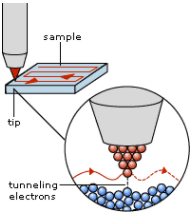Week 8: Nanotechnology + Art
 |
| Newman's Microscopic Text |
This
week’s lectures and readings focused on the history of nanotechnology and its
recently increasing applications. One of
the more fascinating things that I thought we covered in the lectures was the
two competitions offered by Richard Feynman for the advancement of
nanotechnology in 1959. The first was to
build a miniature motor that could fit inside of a 1/64 inch cube and the
second was to reduce the size of a page of a book to a 1/25,000 linear scale (CalTech.edu). The first cash prize of $1,000 was awarded
relatively quickly to William McLellan in 1960, while the second prize took 25
years until Tom Newman completed the task using an electron beam in 1985 (Kornei). Such advancements in nanotechnology have obvious
application in the artistic and literary world, with new art being created out
of nanostructures.
I
also found the invention of the scanning tunneling microscope in the 1980s to
be particularly interesting within the field of nanoscience (NanoScience.com). This microscope contains an extremely fine
tip that scans the surface of an object by reading the electrical signals given
off by the electrons of said object.
This allows the stylus to detect microscopic details of the surface it
is detecting, and an extremely thorough portrayal of such features are
displayed (Nobelprize.org).
 |
| Scanning Tunneling Microscope |
One
last item that caught my attention during this week’s lectures was the concept
of nanoparticles integrated into fabric.
For example, silver nanoparticles embedded within socks for
antibacterial purposes (McKenna). This
aids in reducing the stench associated with one’s feet; however, studies have
shown that the nanoparticles included in fabrics have been prone to leaking out
during washing.
Moving
forward, it is easy to see an increased role that nanotechnology will play in
art. From the shrinking of a page of
literature in the 1980s to the possibility of nanoparticles being included in
and aiding in the preservation of art, nanotechnology will help define art in
the 21st century.
 |
| Silver Nanoparticles in Sock |
References:
“Feynman Pays Up.” ARCHIVES
:: IN THE NEWS, California Institute of Technology, 14 Apr. 2016,
archives.caltech.edu/news/feynman-nanotech.html. Accessed 23 May 2017.
Kornei, Katherine.
“The Beginning of Nanotechnology at the 1959 APS Meeting.” American
Physical Society, Nov. 2016, www.aps.org/publications/apsnews/201611/nanotechnology.cfm.
Accessed 23 May 2017.
McKenna, Phil.
“Smelly Sock Treatment Leaks Silver Nanoparticles.” New Scientist,
7 Apr. 2008,
www.newscientist.com/article/dn13602-smelly-sock-treatment-leaks-silver-nanoparticles/.
Accessed 23 May 2017.
“Scanning
Tunneling Microscopy.” NanoScience Instruments, 2017,
www.nanoscience.com/technology/scanning-tunneling-microscopy/. Accessed 23 May
2017.
“The Scanning
Tunneling Microscope.” Nobelprize.org, 2017,
www.nobelprize.org/educational/physics/microscopes/scanning/. Accessed 23 May
2017.


It was also really interesting for me to find out that there are silver nanoparticles in socks and underwear for antibacterial purposes. It turns out that aside from their use because of their antibacterial properties, nanoparticles are used in some objects to give them colors that wouldn't otherwise be achieved. A couple examples of objects with which we are familiar that use nanoparticles to give them beautiful pigments are pottery and stained glass.
ReplyDelete